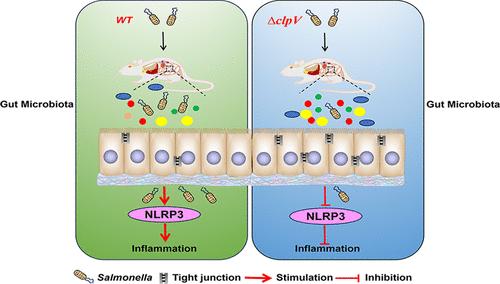当前位置:
X-MOL 学术
›
J. Agric. Food Chem.
›
论文详情
Our official English website, www.x-mol.net, welcomes your
feedback! (Note: you will need to create a separate account there.)
Colonization Mediated by T6SS-ClpV Disrupts Host Gut Microbiota and Enhances Virulence of Salmonella enterica serovar Typhimurium
Journal of Agricultural and Food Chemistry ( IF 5.7 ) Pub Date : 2024-08-19 , DOI: 10.1021/acs.jafc.4c03735 Songbiao Chen 1, 2, 3, 4 , Fuxi Du 1, 2, 3 , Ke Shang 1, 2, 3 , Huimin Chen 1, 2, 3 , Rongxian Guo 1, 2, 3 , Chengshui Liao 1, 2, 3, 4 , Yanyan Jia 1, 2, 3 , Zuhua Yu 1, 2, 3 , Jing Li 1, 2, 3 , Chunjie Zhang 1, 2, 3 , Ke Ding 1, 2, 3, 4
Journal of Agricultural and Food Chemistry ( IF 5.7 ) Pub Date : 2024-08-19 , DOI: 10.1021/acs.jafc.4c03735 Songbiao Chen 1, 2, 3, 4 , Fuxi Du 1, 2, 3 , Ke Shang 1, 2, 3 , Huimin Chen 1, 2, 3 , Rongxian Guo 1, 2, 3 , Chengshui Liao 1, 2, 3, 4 , Yanyan Jia 1, 2, 3 , Zuhua Yu 1, 2, 3 , Jing Li 1, 2, 3 , Chunjie Zhang 1, 2, 3 , Ke Ding 1, 2, 3, 4
Affiliation

|
Salmonella enterica serovar Typhimurium (S. Typhimurium) is a common foodborne enteric pathogen that infects humans or mammals and colonizes the intestinal tract primarily by invading the host following ingestion. Meanwhile, ClpV is a core secreted protein of the bacterial type VI secretion system (T6SS). Because elucidating ClpV’s role in the pathogenesis of T6SS is pivotal for revealing the virulence mechanism of Salmonella, in our study, clpV gene deletion mutants were constructed using a λ-red-based recombination system, and the effect of clpV mutation on SL1344’s pathogenicity was examined in terms of stress resistance, motility, cytokine secretion, gut microbiota, and a BALB/c mouse model. Among the results, ClpV affected SL1344’s motility and was also involved in cell invasion, adhesion, and intracellular survival in the MDBK cell model but did not affect invasion or intracellular survival in the RAW264.7 cell model. Moreover, clpV gene deletion significantly reduced the transcription levels of GBP2b, IFNB1, IL-6, NLRP3, NOS2, and TNF-α proinflammatory factor levels but significantly increased transcription levels of IL-4 and IL-10 anti-inflammatory factors. Last, ClpV appeared to closely relate to the pathogenicity of S. Typhimurium in vivo, which can change the gut environment and cause dysbiosis of gut microbiota. Our findings elucidate the functions of ClpV in S. Typhimurium and illustrating interactions between T6SS and gut microbiota help to clarify the mechanisms of the pathogenesis of foodborne diseases.
中文翻译:

T6SS-ClpV 介导的定植破坏宿主肠道微生物群并增强肠沙门氏菌鼠伤寒血清型的毒力
鼠伤寒沙门氏菌( S. Typhimurium)是一种常见的食源性肠道病原体,它感染人类或哺乳动物,并主要通过摄入后侵入宿主而在肠道定殖。同时,ClpV是细菌VI型分泌系统(T6SS)的核心分泌蛋白。由于阐明ClpV在T6SS发病机制中的作用对于揭示沙门氏菌的毒力机制至关重要,因此本研究利用基于λ-red的重组系统构建了clpV基因缺失突变体,并考察了clpV突变对SL1344致病性的影响在抗应激、运动性、细胞因子分泌、肠道微生物群和 BALB/c 小鼠模型方面。结果显示,在MDBK细胞模型中,ClpV影响SL1344的运动性,并参与细胞侵袭、粘附和细胞内存活,但在RAW264.7细胞模型中不影响侵袭或细胞内存活。此外, clpV基因缺失显着降低了GBP2b、IFNB1、IL-6、NLRP3、NOS2和TNF-α促炎因子的转录水平,但显着增加了IL-4和IL-10抗炎因子的转录水平。最后,ClpV似乎与鼠伤寒沙门氏菌在体内的致病性密切相关,它可以改变肠道环境并导致肠道菌群失调。我们的研究结果阐明了 ClpV 在S中的功能。鼠伤寒菌和阐明 T6SS 与肠道微生物群之间的相互作用有助于阐明食源性疾病的发病机制。
更新日期:2024-08-19
中文翻译:

T6SS-ClpV 介导的定植破坏宿主肠道微生物群并增强肠沙门氏菌鼠伤寒血清型的毒力
鼠伤寒沙门氏菌( S. Typhimurium)是一种常见的食源性肠道病原体,它感染人类或哺乳动物,并主要通过摄入后侵入宿主而在肠道定殖。同时,ClpV是细菌VI型分泌系统(T6SS)的核心分泌蛋白。由于阐明ClpV在T6SS发病机制中的作用对于揭示沙门氏菌的毒力机制至关重要,因此本研究利用基于λ-red的重组系统构建了clpV基因缺失突变体,并考察了clpV突变对SL1344致病性的影响在抗应激、运动性、细胞因子分泌、肠道微生物群和 BALB/c 小鼠模型方面。结果显示,在MDBK细胞模型中,ClpV影响SL1344的运动性,并参与细胞侵袭、粘附和细胞内存活,但在RAW264.7细胞模型中不影响侵袭或细胞内存活。此外, clpV基因缺失显着降低了GBP2b、IFNB1、IL-6、NLRP3、NOS2和TNF-α促炎因子的转录水平,但显着增加了IL-4和IL-10抗炎因子的转录水平。最后,ClpV似乎与鼠伤寒沙门氏菌在体内的致病性密切相关,它可以改变肠道环境并导致肠道菌群失调。我们的研究结果阐明了 ClpV 在S中的功能。鼠伤寒菌和阐明 T6SS 与肠道微生物群之间的相互作用有助于阐明食源性疾病的发病机制。































 京公网安备 11010802027423号
京公网安备 11010802027423号